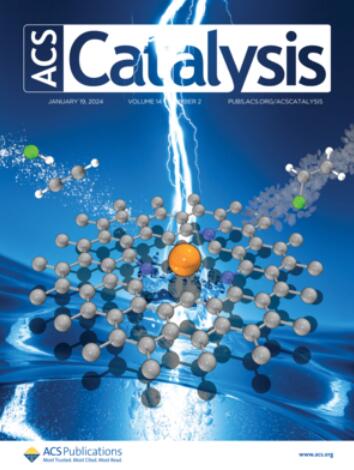在单原子掺杂的金银表面简单合成三角木烯
IF 11.3
1区 化学
Q1 CHEMISTRY, PHYSICAL
引用次数: 0
摘要
本文章由计算机程序翻译,如有差异,请以英文原文为准。

Triangulene Synthesis Made Simple on Single-Atom-Doped Gold and Silver Surfaces
Triangulene, the smallest triplet-ground-state polybenzenoid, has previously been successfully synthesized by tip-manipulation experiments, employing scanning probe techniques to dehydrogenate precursor molecules under ultrahigh vacuum and low-temperature conditions. Here, we propose an alternative approach to form triangulene on (111)-facets of gold and silver doped by single noble metal atoms (Ru, Rh, Pd, or Pt), predicted by density functional theory calculations in combination with microkinetic analysis. Our results convey two key insights. First, the isolated single atoms reduce the activation energies for the dehydrogenation of dihydrotriangulene (the precursor molecule) and make the reactions more favored compared to pure Au(111) and Ag(111). In particular, we find that Rh- and Ru-doped surfaces outperform other considered single-atom-doped surfaces with nearly 100% yield of triangulene when the initial coverage of precursor is low. Second, two independent descriptors─the H and intermediate adsorption energies─are found to predict the triangulene formation activity on the single-atom-doped surfaces via scaling relations for activation and reaction energies. Based on these descriptors, a two-dimensional yield map for triangulene formation is constructed, providing valuable design insights for experimentalists. Our theoretical work suggests a straightforward thermal synthesis pathway for triangulenes, offering a more efficient alternative to prevalent tip-induced manipulation techniques and high-temperature approaches.
求助全文
通过发布文献求助,成功后即可免费获取论文全文。
去求助
来源期刊

ACS Catalysis
CHEMISTRY, PHYSICAL-
CiteScore
20.80
自引率
6.20%
发文量
1253
审稿时长
1.5 months
期刊介绍:
ACS Catalysis is an esteemed journal that publishes original research in the fields of heterogeneous catalysis, molecular catalysis, and biocatalysis. It offers broad coverage across diverse areas such as life sciences, organometallics and synthesis, photochemistry and electrochemistry, drug discovery and synthesis, materials science, environmental protection, polymer discovery and synthesis, and energy and fuels.
The scope of the journal is to showcase innovative work in various aspects of catalysis. This includes new reactions and novel synthetic approaches utilizing known catalysts, the discovery or modification of new catalysts, elucidation of catalytic mechanisms through cutting-edge investigations, practical enhancements of existing processes, as well as conceptual advances in the field. Contributions to ACS Catalysis can encompass both experimental and theoretical research focused on catalytic molecules, macromolecules, and materials that exhibit catalytic turnover.
 求助内容:
求助内容: 应助结果提醒方式:
应助结果提醒方式:


